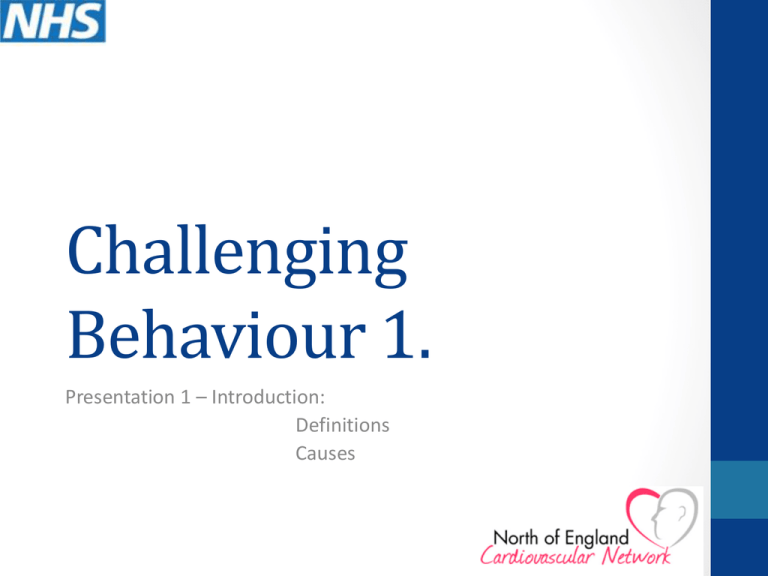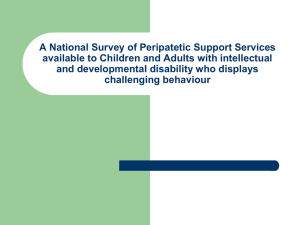Challenging behaviour has been defined as
advertisement

Challenging Behaviour 1. Presentation 1 – Introduction: Definitions Causes Challenging Behaviour (CB) • The presentation series on CB will: • Develop your understanding of the definition of challenging behaviour • Highlight how they develop and continue • Develop your ability to understand what challenging behaviours may be trying to communicate • Help you to identify proactive and reactive strategies to managing challenging behaviour Challenging Behaviour (CB) • Challenging behaviour has been defined as: “Any behaviour, or lack of behaviour of such intensity, frequency and/or duration that has the potential to cause distress or harm to clients/carers/staff or one which creates feelings of discomfort, powerlessness, frustration, fear or anxiety. It is also behaviour, which delays or limits access to ordinary community facilities and is outside socially acceptable norms.” Eric Emerson (1995) Challenging Behaviour (CB) • And: “All behaviour has meaning….” Challenging Behaviour (CB) • CB is often subjectively determined: • Personally – someone may view some behaviours as challenging, whereas another person may not. • Situationally – some behaviours (e.g. Sexualised behaviour) are only challenging if it occurs in inappropriate contexts or situations. • Socially/Culturally – some behaviours may be culturally determined and may be acceptable in one culture, but not another. Spend a minute or so on the following tasks: • List some CBs which are ‘challenging’ because they: • Happen too often • Do not happen often enough (or at all) • List some CBs which are ‘challenging’ because they are: • Too intense/severe • Not intense enough • List some CBs which are only ‘challenging’ because they happen out of context (e.g. wrong time, place, people) Causes of Challenging Behaviour • CB can arise for many reasons, and are seen in populations across society. For our purposes, we will restrict our presentation and exercises to CBs when they typically occur in a hospital setting and with stroke patients. • Challenging behaviours can be caused and maintained by many things: • Medical/physical e.g.: pain, physical hypersensitivity to noise or light (or reduced sensitivity), medication effects, illness/respiratory problems, insomnia, confusion/delirium, nausea, reduced mobility, dysphasia, dysphagia, dysarthria, reduced vision or hearing. Causes of Challenging Behaviour • Environmental e.g. - Light or darkness, temperature, noise, silence, lack of sensory stimulation, overstimulation (including too much interaction), uncomfortable furniture, overcrowding, isolation, poor food, wrong type of food, Ward ‘routine’. • Social & Communication - Boredom, social isolation, difficulty in communication with others or overstimulation through social contact (e.g. Too many visitors, too many or too complicated questions or too many conversations going on). Causes of Challenging Behaviour •Psychological – Each person obviously brings their own personalities and past experiences with them, as they adjust to the effects of their stroke and some people manage this adjustment process in different ways. People may experience depression, anxiety, grief & loss and frustration and these psychological experiences may be responsible for some challenging behaviours. •Cognitive – Brain injury from the stroke can lead to impaired insight into difficulties, impaired reasoning ability, impulsivity, mood swings, hyperemotionality and reduced motivation (including poststroke apathy syndrome which may be mistaken for depression or poor motivation, but is actually a neurological condition). Challenging Behaviour • To complete the ‘Challenging Behaviour’ module, proceed to the following presentations: • Challenging Behaviour 2. – Assessment • Challenging Behaviour 3. - Interventions Thank you for your interest.






